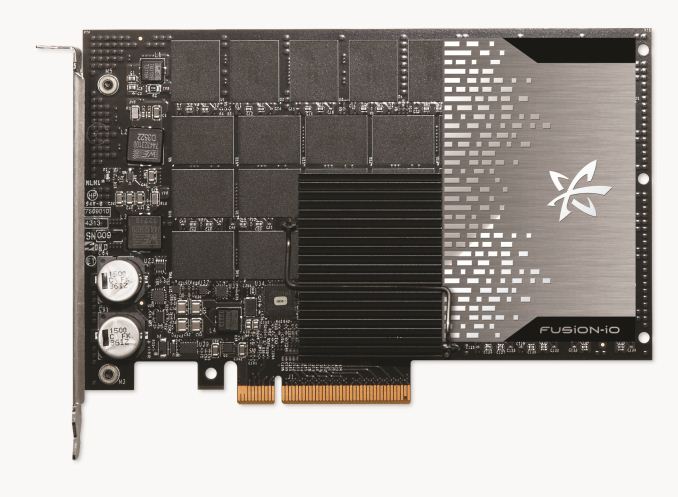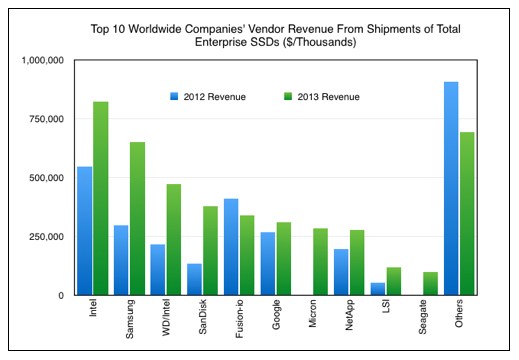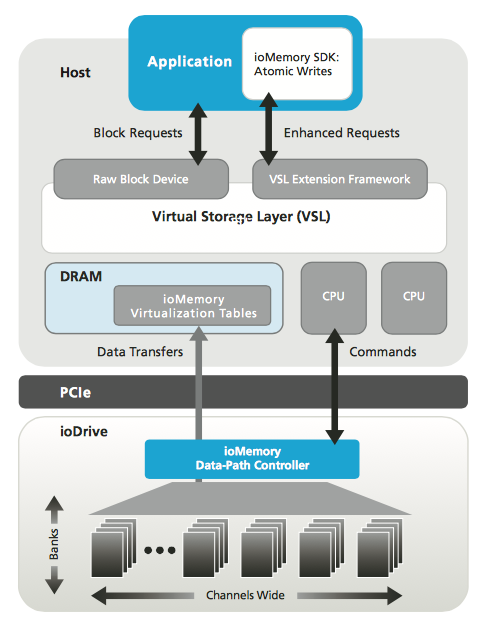The State of SanDisk
by Kristian Vättö on December 5, 2014 8:00 AM ESTThe Enterprise
In mid-July SanDisk announced their acquisition of Fusion-io and the acquisition was completed a couple of week prior to Flash Memory Summit. I posted my initial thoughts when the news hit the public, but I feel that it's worth doing a bit deeper analysis now that I have given it some more thought and discussed it with John Scaramuzzo, senior vice president and general manager of SanDisk's enterprise business.
SanDisk has managed to establish itself as one of the key players in the enterprise SSD space over the past few years. The acquisitions of Pliant in 2011 and SMART Storage Systems in 2013 provided SanDisk with strong expertise and product lineups for SATA and SAS SSDs but left the company without a solid long-term plan for PCIe. I heard Pliant's initial roadmap included plans for PCIe-based solutions as well, but it looks like those plans never materialized.
Up until the Fusion-io acquisition, the Lightning PCIe SSA was the only PCIe solution in SanDisk's enterprise product portfolio, and as a matter of fact that drive is internally a SAS-based design with a PCIe to SAS bridge onboard. In other words, SanDisk had practically zero real PCIe solutions for the enterprise, while at the same time SanDisk's biggest competitors, such as Intel and Samsung, have had PCIe drives for a long while already.
Fusion-io's 3.2TB Atomic Series SSD
Fusion-io's strategy and product portfolio, on the other hand, was a complete opposite. From the beginning Fusion-io has focused on PCIe storage, which dates all the way back to 2007 when the company released its first ioDrive that utilized a PCIe x4 interface and was capable of speeds up to 800MB/s. Not only was Fusion-io early in the market, but the company was also able to garner a few massive and very important clients – the most notable being Facebook and Apple. I don't think it's an overstatement to say that Fusion-io can be considered as the pioneer of PCIe storage because it was the first company to turn PCIe SSDs and storage in general into a large, successful business.
But stories eventually come to an end. The competitive advantages Fusion-io had were its PCIe technology and several high-level customers, but the advantages were lost when the NAND manufacturers stepped into the PCIe territory. It's nearly impossible for a company that has to source its NAND from a third party to compete against another company that manufactures NAND in-house since the latter will always have advantages in cost. While Fusion-io didn't lose its customers to competitors overnight, it's clear that especially Intel and Samsung snagged a share of Fusion-io's business in the past couple of years.
In a nutshell, the acquisition brings SanDisk the long-needed expertise in PCIe storage along with Fusion-io's broad PCIe product portfolio. The acquisition is now a bit over 100 days in and the Fusion-io employees have been integrated into SanDisk's existing teams. Initially Fusion-io's engineering team was separate and worked under Lance Smith, the former President and COO of Fusion-io, but Mr. Smith decided to leave SanDisk and pursue other options. Last week a data virtualization startup Primary Data announced that Mr. Smith has joined the company as the new CEO, which explains his quick departure from SanDisk.
All the engineering talent has now been unified and the team is lead by Mr. Scaramuzzo. With everyone under the same roof, the roadmaps are now in the process of being integrated to bring the expertise together. It will be a while before we see the fruits of the acquisition, but in the meantime the latest Fusion-io products will transition to SanDisk NAND for increased cost efficiency.
But what about NVMe? That has been the hot topic in the industry this year and I bet many of you are wondering what is SanDisk's and Fusion-io's play in that field. The short version of their strategy is that Fusion-io already has a technology called Virtual Storage Layers (VSL), which is essentially a driver/software stack similar to NVMe. The truth is that NVMe isn't really anything new from a technology perspective, but what makes it alluring for many manufacturers is the fact that the NVMe drivers are universal and already supported by the latest operating systems. Technologies like VSL are rather expensive to develop and require expertise because there is no framework available (i.e. everything has to be developed from scratch), but on the other hand an in-house driver like VSL allows for more customization and optimization.
However, that doesn't mean that SanDisk has no interest on NVMe whatsoever. The company sees that as the entry and mid-level enterprise SSDs move from SATA and SAS to PCIe, NVMe will be one of the key factors because of easy and quick deployment. For that market segment the NVMe spec and its limitations are fine – it's only the high-end segment where the benefits of VSL are more prominent. It's actually likely that many manufacturers will turn to custom NVMe drivers anyway for higher and more optimized performance, and in fact that is already happening with Intel providing its own NVMe driver for the P3600/P3700.
Lastly, let's quickly discuss the ULLtraDIMM. I wrote a quick piece on ULLtraDIMM right after Flash Memory Summit, but SanDisk has already scored Huawei as the third ULLtraDIMM partner (in addition to IBM and Supermicro). The first generation product that is currently available is internally based on a pair of SATA 6Gbps controllers, but SanDisk said that a native DDR to NAND controller is possible in the future if the market adopts the new form factor well. As usual, the industry is fairly slow in adopting new form factors, so it's hard to say whether NAND DIMMs will really take off, but it's a very interesting and potentially useful technology.
Final Words
All in all, SanDisk is definitely one of the most interesting NAND companies going forward. USB drives, eMMC solutions, SSDs and even the storage arrays from the Fusion-io acquisition are all built on NAND, which puts SanDisk in a unique position as it's the only NAND manufacturer that focuses solely on NAND products. The company can't turn to alternative revenue sources like e.g. Intel and Samsung can, but on the other hand that's also SanDisk's strength as all the know-how and experience in the company is related to NAND in one way or the other.
Ultimately next year will be crucial for SanDisk because it determines whether the company can materialize all the underlying potential from the Fusion-io acquisition and become a serious competitor to Intel and Samsung in the enterprise space. The pieces are definitely there, so it's just a matter of execution now.














132 Comments
View All Comments
mojoxer - Friday, December 5, 2014 - link
Quit thinking about consumers. Partner with a major OEM (Dell or HP) to manufacture desktops for government and enterprise workstations. Use mSATA or SATA SSDs in the 64-128GB range for the OS install, as most government and enterprise users store the majority of their data on the enterprise server farms. Heavily market the automated hardware encryption for the local storage, as well as the increased reliability over the rotating disks. Reduced startup time is also a significant resource opportunity if you shave 2 minutes off the startup of 1,500 workstations in a single government office.Concillian - Friday, December 5, 2014 - link
Concincing OEMs is your biggest issue. I recently bought my wife a laptop. What I wanted was a low end CPU, IPS screen and SSD. You know what I found? ZERO OPTIONS. Can't get a low end CPU with a nice screen, only an i7. The model we settled on was nearly $1k and DIDN'T HAVE AN OPTION FOR AN SSD... I guess that's an upgrade down the road.'nar - Friday, December 5, 2014 - link
I am reminded of LCD panels and why they went to wide-screen formats. A 19" square cost more, and typical users did not understand why. When you do not know why, you only choose what you do know, price.I can understand OEM reluctance to add to the base cost, but they should add the option to the base unit. Many OEM's do not even have an SSD option that is priced anywhere near what they cost individually on the market. Many users just buy whatever is in the stores, or they insist on a "Dell" or whatever. They defer technical specifications to the OEM since they do not or cannot understand them.
You cannot hope to get the low-price segment until SSD's surpass HD in price per GB. You always get what you pay for. Better off targeting the discretionary spending on computers in the mid to high end where they are adding discrete graphics, beefier PSU's, water cooling, and higher-end computer cases.
It really should be easy when you speak to someone. What is the number one complaint about computers? They are slow. What is the slowest component in computers today? Spinning hard drives. Are you willing to pay more for a faster computer? End of discussion, that question is rhetorical. They have to make their own opinion.
Wall Street - Friday, December 5, 2014 - link
I just upgraded from a ReadyCache SSD accelerator to a 480 GB Ultra II during the Black Friday sales. I think that up until this year, for me, price was a primary deterrent to buying an SSD. Also, I think that a lot of people have been watching the bad press generated by OCZ, the Intel 8 MB bug, and Samsung;s recent TLC problems. I actually chose the Sandisk Ultra II because there products seem to have not experienced these bugs so far. Until it is clear that SSDs have passed their teething problems, everyone is going to view them as the potential new IBM GXP 60 Deathstar model that has potential future reliability problems.One of the tech guys at work asked how my SSD experience has been. I have honestly had to say that while I as an enthusiast found the ReadyCache to work well and the Ultra II is good so far, it is hard to recommend upgrading SSDs wildly given the bugs and the reputation risk of such a recommendation.
If I were SanDisk, I would focus on both speed and reliability. For example, the Ultra II that I bought is a relatively new drive and really only the second manufacturer on the market to use TLC. I think that the two pronged approach is needed to sell SSDs: 1) speed, which is easy to show based on the boot times and 2) reliability which would rely on customer testimony, warranty and data points lie Tech Report's SSD endurance experiment.
truongpham - Friday, December 5, 2014 - link
As I see around the web what is manufacturers want is not exactly customer want. The customer I mentioned here is casual customers. Who need faster start up, short program load and less shutdown time. In my personal viewpoint the hydrid HDDs is the best. The common size I think 1TB or 02 TB mechanic with 32GB SSD is enough. With my a amateur gamer I need 4TB or 6TB mechanic with 32GB SSD is ok. We need 300MB/s sequence read or wirte. 50k IOPS is enough.stancilmor - Saturday, December 6, 2014 - link
Getting non-computer people to upgrade a mechanical harddrive to an SSD isn't going to happen unless they have a computer friend that does the upgrade for them. I've personally bought and paid for 6 upgrades from mechanical drives to 256 GB SSDs for my non-computer friends...still have 3 or 4 more friends to upgrade. I buy the drive, borrow their computer, clone the drive, and then install the SDD, and give them their mechanical drive in a USB enclosure.From and industry stand point this means a (likely a free) service (either bring your computer in to the store and we'll upgrade it or we'll send a tech to your house and upgrade it).
The real battle is to get OEMs to quit using mechanical drives and start using SSDs. We still have the problem with not enough RAM. Before I upgraded to Windows 8.1 with 32 GB RAM, I had my XP machine tuned to boot with less than 180MB RAM, so that the remaining 3.2GB could be used for programs...I was almost always running out of RAM. I have friends that would complain that their system was slow...1GB RAM, but 4GB of virtual memory running all this software grinding away on the mechanical drive. Most of the time they had no idea what the software was or why it was one their machine.
My system is setup with hot plug system drives. One is an SSD and the rest are mechanical drives. I have an i5-3570k with 32 GBytes of RAM. I can tell you first hand there are times when the system is busy for 10s of minutes waiting on the mechanical drive (processor is nearly idle, but drive is at 100% busy), but when I do the same tasks with the SSD I don't notice the slow down (I'll still see the SSD at 100% busy, but the system remains functional for other drive access related tasks). I have the same problem at work only worse...slow mechanical drive that is encrypted, constantly backing up, constantly scanning for viruses, and constantly being monitored by the company IT security...That computer is also an i5, but it can take up to 45 minutes to boot. I've often thought about swapping the drive for and SSD, but my job isn't worth the risk of altering company property...so I just sit there and wait on the mechanical drive.
cm2187 - Saturday, December 6, 2014 - link
From my point of view, I don't need faster SSDs. Beating the SATA 3 specs won't have any visible impact on my usage. What I need is larger capacities and lower prices.StrangerGuy - Saturday, December 6, 2014 - link
Exactly, SSD performance is already good enough for the average user. The only thing left to work on is the price.KingCobra_14 - Saturday, December 6, 2014 - link
I think that in lesser developed countries like India where I live, the awareness of NAND storage is very less. As said above in the article, live demonstrations in Malls and shopping centers especially in metro cities would be a huge boon for consumers who want to make their PC faster just by a simple upgrade. There are not many high end PC users in the Indian market so they would most definitely consider the cheapest option. Processor: No, Graphics Card: Not worth unless you are a gamer, RAM: Probably if you have very less RAM to start with, SSD: YES.Rocket321 - Saturday, December 6, 2014 - link
Thinking about my parents, they need to really see it in action. They also don't buy much online. So I think to target the baby boomer and average Joe, having a well educated staff at retail stores is going to be the best. Price is high on the list as well - they were looking to spend just enough to get something that works, but not more. So an informed associate at Best buy with a demo station which lets buyers compare a ssd to a hdd side by side.Thinking back a few years when many people were on dial-up internet, there was a lot of success marketing DSL and cable as 10x, 30x, 600x faster than dial-up. I think putting the added performance in simple terms like this could also go a long way to reaching the average user.